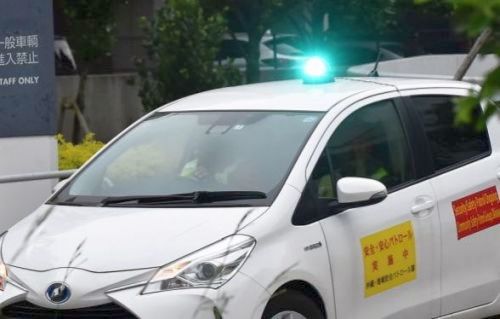Despite promises to curtail incidents involving the U.S. military, the Japanese government’s Okinawa regional safety patrol reports 75% of their incident responses involve drunkenness, only 0.7% involve the U.S. military

An Okinawa Regional Safety Patrol car setting out on patrol with the blue light on top of the car lit. June 16, Naha
June 21, 2019 Ryukyu Shimpo
After the 2016 incident in which an ex-Marine U.S. military base worker murdered a woman in Okinawa, the Japanese government created the “Okinawa Regional Safety Patrol” as a policy to prevent further incidents, which to-date has cost around 1.5 billion yen. It was recently announced that 75% of the incidents said patrol has dealt with were for drunkenness such as people asleep on the road, while reporting only 6 incidents related to the U.S. military, just 0.7% of the total 855 incidents in the past three years. The efficacy and cost-efficiency of the patrol, which was started in order to prevent incidents involving the U.S. military, is now being brought into question. The Okinawa General Bureau (OGB) explained, “They are not here just to deal with U.S. soldiers,” and said that there were results that point to crime deterrence that are not reflected in the statistics.

According to the OGB, from June 2016 through the end of 2018, the total number of incidents reported to the police by the safety patrol was 855. Incidents involving drunk people totaled 645, 75.4% of the total incidents. Additionally, there were 41 incidents involving juveniles, and 16 involving suspicious persons, none of which were related to U.S. soldiers or U.S. military base workers. The six incidents involving the U.S. military included three cases of people asleep on the road, two traffic stops, and one fight/argument.
Okinawa International University professor Hiroyuki Teruya (Public Administration) indicates, “This is a far departure from the nature of previous incidents and accidents involving the U.S. military. I think many people in Okinawa are also unaware of this.”
The budget spent on patrol activities has run a total of 2.68 billion yen in 2016 and 6.26 billion yen in 2017. The costs for 2018 are still being calculated by the government, but the forecast for the three-year total is around 1.5 billion yen. Cabinet data suggests that the patrol costs around 2 million yen per day.
In Okinawa, there were 23 crimes committed by people related to the U.S. military in 2016. In 2017, that number rose to 48, a five-year high. In 2018, the total number of crimes was 31.
The OGB Safety Policy Director, Yasushi Namihira, explained, “The patrols we are carrying out are not meant for just the U.S. military. There are also crime deterrents that do not appear in the statistics.” He further stressed, “If we only track success by the numbers, then the regional crime prevention patrol would be in the same boat, which is meaningless.”
(English translation by T&CT and Sam Grieb)
Previous Article:Final day of the Makishi Public Market in photos
Next Article:Japanese government knew of Kadena Air Base’s PFOS contamination, did not disclose it
[Similar Articles]
- Patrol unit formed after 2016 military incident “doesn’t target specific entity,” government says
- Japanese government aims to streamline Blue Patrol program by mobilizing 3,600 taxis in Okinawa for crime prevention next year
- Japan’s crime-prevention patrols receive zero calls related to the U.S. military in 6 months despite consecutive crimes
- 555.6 billion yen paid towards the maintenance and repair of U.S. military facilities in Okinawa
- Low indictment rate for crimes involving U.S. military personnel in Okinawa
 Webcam(Kokusai Street)
Webcam(Kokusai Street)


